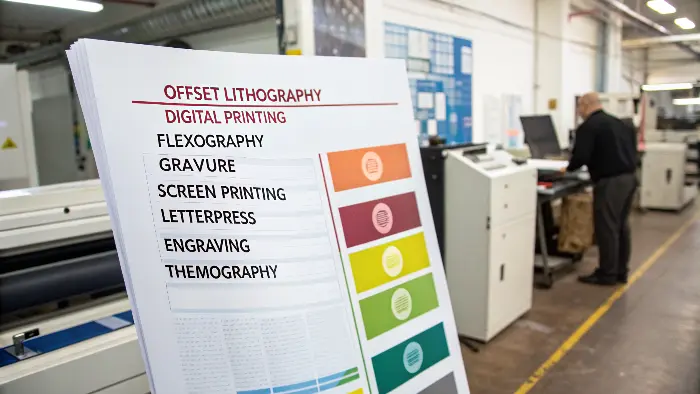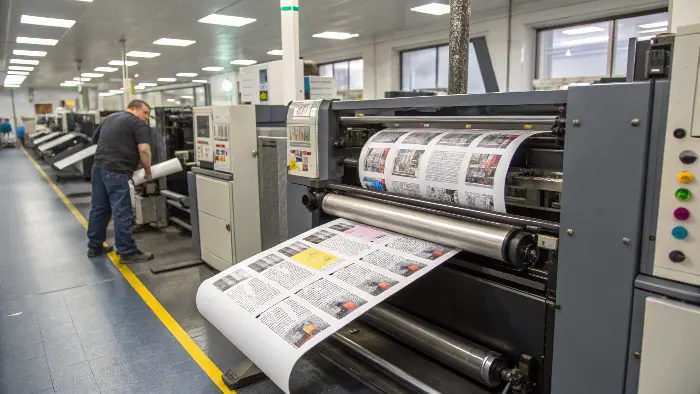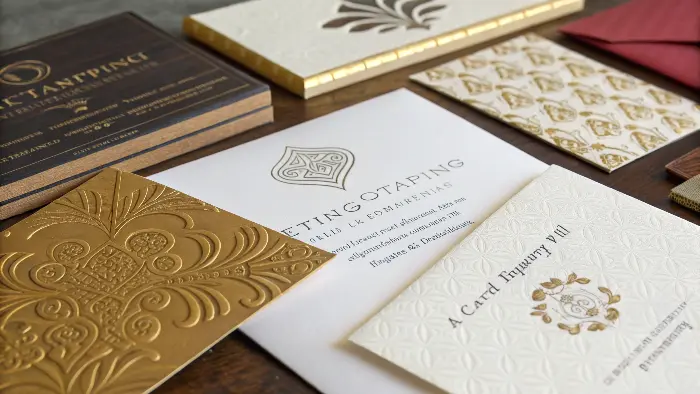Tired of stationery that just blends in? Standard printing is fine, but it rarely wows. You want products that feel as good as they look, making a real statement.
Specialty printing techniques like embossing, letterpress, and foil stamping add unique visual and tactile elements, transforming ordinary stationery into premium, memorable products that truly stand out.
This isn’t just about slapping some ink on paper. Oh no. We’re talking about creating an experience. When Michael from Germany asks us at Panoffices for "something with a premium feel" for his new collection, he’s often hinting at these kinds of techniques. It’s about more than just conveying information; it’s about conveying quality and thoughtfulness. Let’s explore some of these amazing methods that can take a simple notebook or card from "meh" to "must-have!"
What are the 4 main types of printing, really?
Feeling a bit lost in all the printing jargon out there? It can seem like a whole other language! Understanding the basic categories can really help you choose wisely for your project.
The four major traditional printing categories are relief (like letterpress), intaglio (like engraving), planographic (like offset lithography), and stencil (like screen printing). Each has its own unique process and effect.
Okay, let’s break these down because knowing the basics is super helpful, even when we’re aiming for something fancy. Think of these as the big families of printing.
1. Relief Printing
This is probably the oldest method. Imagine a rubber stamp – that’s relief printing! The image or text is raised on the printing plate. Ink is applied to this raised surface, and then it’s pressed onto the paper. Letterpress is a classic example, and it’s making a huge comeback for that gorgeous, tactile, debossed (pressed in) look. When Michael wants a truly artisanal feel for a limited edition Panoffices notebook, letterpress is often a top contender because of that distinct impression.
2. Intaglio Printing
This is kind of the opposite of relief. Here, the image is cut or etched into the printing plate. Ink is applied to the plate and then wiped off the surface, leaving ink only in the recessed lines. When paper is pressed against the plate with a lot of force, it picks up the ink from these grooves. Engraving, used for fancy invitations and currency, is a type of intaglio. It creates a raised ink effect on the paper, which feels incredibly elegant. It’s a bit more complex and costly, so it’s reserved for really high-end items.
3. Planographic Printing
"Plano" means flat. In this method, the printing and non-printing areas are on the same flat surface (the plate). It works on the principle that oil and water don’t mix. The image area is treated to accept ink (which is oil-based) and repel water, while the non-image area is treated to attract water and repel ink. Offset lithography is the most common example and is used for most commercial printing like books, magazines, and many of our standard Panoffices stationery items because it’s fast and economical for large runs.
4. Stencil Printing (or Porous Printing)
With this method, ink is forced through a screen or stencil onto the paper. Screen printing is the best-known example. You can print on almost anything with screen printing – paper, fabric, plastic, wood. It’s great for bold graphics and can lay down a thick, vibrant layer of ink. We’ve used it for some cool, graphic Panoffices tote bags and special edition binder covers.
Understanding these fundamental types helps appreciate where the specialty techniques we’ll talk about fit in, or how they build upon these basics.
What are the 8 types of printing methods to know?
Okay, so the four main categories are a good start, but what specific methods are commonly used today? Knowing the options helps you pick the perfect one for your stationery project.
Common printing methods include offset lithography, digital printing, flexography, gravure, screen printing, letterpress, engraving, and thermography. Each offers different strengths for various applications.
 Let’s dive a bit deeper into some of these, especially those relevant to creating awesome stationery. Some of these we’ve touched on, but let’s expand. |
Printing Method | Quick Description | Best for Stationery When… | Panoffices Example |
|---|---|---|---|---|
| Offset Lithography | Ink transferred from plate to blanket to paper. | You need high volume, good quality, and cost-effectiveness. | Standard Panoffices notebooks, planner pages, large print runs. | |
| Digital Printing | Directly from digital file to printer (laser/inkjet). | You need short runs, personalization, or quick turnaround. | Custom-named Panoffices journals, sample prints for Michael. | |
| Flexography | Relief printing with flexible plates, fast drying ink. | Printing on packaging, labels, or uneven surfaces. | Maybe printed corrugated boxes for Panoffices product shipping. | |
| Gravure | Image etched into cylinder, high speed, high quality. | Very high volume, high-detail magazines, packaging. | Less common for typical stationery, more for mass packaging. | |
| Screen Printing | Ink pushed through a mesh stencil. | Bold graphics, printing on various materials (fabric, plastic). | Special edition Panoffices tote bags, unique binder designs. | |
| Letterpress | Relief printing creating an impression in the paper. | You want a luxurious, tactile, handcrafted feel. | Premium Panoffices invitation sets, high-end journal covers. | |
| Engraving | Intaglio, ink from incised lines, raised on paper. | You need ultimate formality and elegance. | Very exclusive Panoffices correspondence cards. | |
| Thermography | Powder resin fused with ink by heat, creating a raised effect. | You want a raised print effect, less costly than engraving. | Business cards, invitations for a tactile but budget option. |
So you see, it’s not just about picking one. When Michael and I discuss a new product, like a gift set, we might actually consider multiple techniques. For example, the planner pages might be offset for cost and volume, the gift box itself might use flexography, and a special "thank you" card included could be letterpress to add that touch of luxury. My insight is that specialty printing techniques like embossing, letterpress, and foil stamping can elevate premium stationery, enhancing visual and tactile appeal. These really shine when you want to make an impression. Compared to standard methods like digital or offset, which are great for efficiency, these specialty options offer a unique, almost handcrafted dimension that people can see and feel. That’s a big deal for premium products.
What is the most widely used commercial printing technique today?
With so many methods, which one do businesses rely on most for everyday printing needs? Knowing this helps understand the baseline from which specialty techniques diverge.
Offset lithography is the most widely used commercial printing technique globally due to its balance of high quality, speed, and cost-effectiveness for medium to large print runs.

Yeah, if you’re talking sheer volume and widespread use, offset lithography is king. There’s a good reason for it. Think about newspapers, magazines, brochures, books, and a huge chunk of the general stationery we produce at Panoffices – most of it rolls off an offset press. Why? Well, it hits a sweet spot.
First, quality. Offset can produce really sharp, clean images and text with consistent color. Once the setup is done, it can churn out thousands, even millions, of impressions, and they’ll all look pretty much identical. This is super important for branding – Michael needs the Panoffices logo to look exactly the same on every single notebook, no matter how many we print.
Second, speed and volume. These presses are fast. Really fast. They’re designed for large quantities. The initial setup (making the printing plates, getting the press ready) takes some time and has a cost, but once it’s running, the cost per piece drops dramatically as the volume goes up. This makes it very economical for anything beyond a few hundred copies.
Third, versatility. Offset can print on a wide range of paper types and weights. It can handle different finishes too. Whether it’s a glossy catalogue or a matte-finish planner insert, offset can usually do the job.
However, because of that setup cost, it’s not ideal for very small print runs. If Michael only needs, say, 50 special edition notebooks for a small corporate client, offset would be too expensive. That’s where digital printing often steps in. But for the bulk of commercial work, offset is the workhorse. It provides that reliable, good-quality base. My insights about specialty techniques like embossing and foil stamping stand in contrast to this; they aren’t about mass volume in the same way. They’re about adding value and distinction on top of, or instead of, what standard offset provides.
What is the highest quality printing method for stationery?
When you want your stationery to scream "luxury" and "premium," which printing methods deliver the absolute best results? This is where we really get into the good stuff!
Defining the "highest quality" is subjective, but methods like engraving, letterpress, foil stamping, and embossing are often considered top-tier for their unique tactile and visual richness, ideal for premium stationery.

This is where I get really excited because it’s where Panoffices truly shines in creating those "wow" products for clients like Michael. While "highest quality" can depend on what you’re trying to achieve, for premium stationery, it usually means creating a rich sensory experience. My insights point directly to techniques like embossing, letterpress, and foil stamping because they offer unique advantages over standard digital or offset printing. Let’s break these down, because they are just fantastic:
- Letterpress Printing: As we touched on, this relief method presses the design into the paper, creating a debossed effect you can see and feel. It often uses thick, luxurious paper (like cotton stock) to really show off that impression. The ink can be incredibly vibrant. It has a handcrafted, artisanal quality that just feels special. It’s not just printing; it’s sculpting the paper. When Michael wants a product to feel timeless and sophisticated, letterpress is a go-to.
- Engraving (Intaglio): This is the epitome of classic elegance. The ink is raised off the surface of the paper, creating a very distinct tactile feel. It’s incredibly sharp and detailed. Traditionally used for formal invitations and high-end business stationery, engraving has an undeniable cachet. It’s a more complex and often more expensive process, but the result is unparalleled for certain applications.
- Foil Stamping: Want some shine? Foil stamping is your friend! It uses heat and pressure to apply a metallic or pigmented foil to the paper. Gold, silver, copper, rose gold, even holographic or matte foils – the possibilities are amazing. It adds an instant touch of luxury and drama. We often use it at Panoffices for logos on premium notebooks or elegant borders on cards. It’s visually stunning and feels smooth and distinct.
- Embossing & Debossing: These techniques create a raised (emboss) or recessed (deboss) design on the paper without ink (though you can combine them with ink, which is called "ink embossing" or "registered embossing"). A "blind" emboss (no ink) is incredibly subtle and sophisticated. It plays with light and shadow and adds a wonderful textural element. Imagine a beautifully embossed monogram on a journal cover – pure class.
Why are these "higher quality" for premium items?
Compared to standard offset or digital printing which lay ink flat on the surface, these methods engage more senses.- Tactile Appeal: You can feel the design. The impression of letterpress, the raised ink of engraving, the smooth surface of foil, the dimensionality of embossing – this is huge.
- Visual Depth: They create shadows and highlights, adding a richness that flat printing can’t match.
- Perceived Value: These techniques signal craftsmanship and attention to detail, which inherently increases the perceived value of the product.
When Michael specifies a "luxury feel" for a Panoffices product, we often combine these. Perhaps a letterpress printed card with a foil-stamped logo. Or an embossed cover on a journal. These aren’t just printing methods; they are design elements in themselves. 🔥Conclusion
Specialty printing techniques transform stationery from mere paper into an experience. They add tactile beauty and visual pop, making products truly memorable and premium. It’s all about that special touch!

